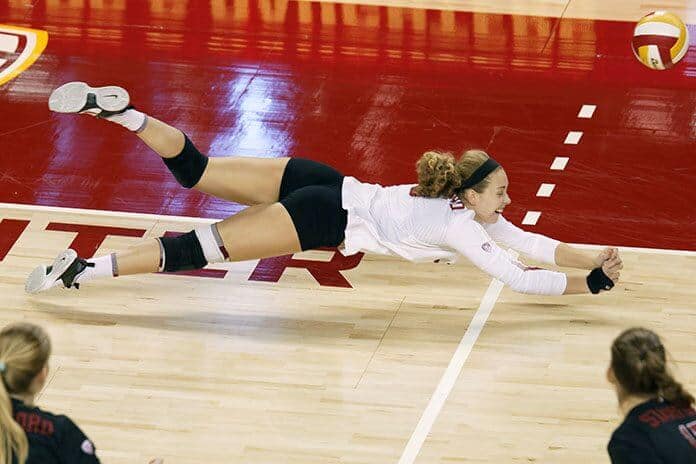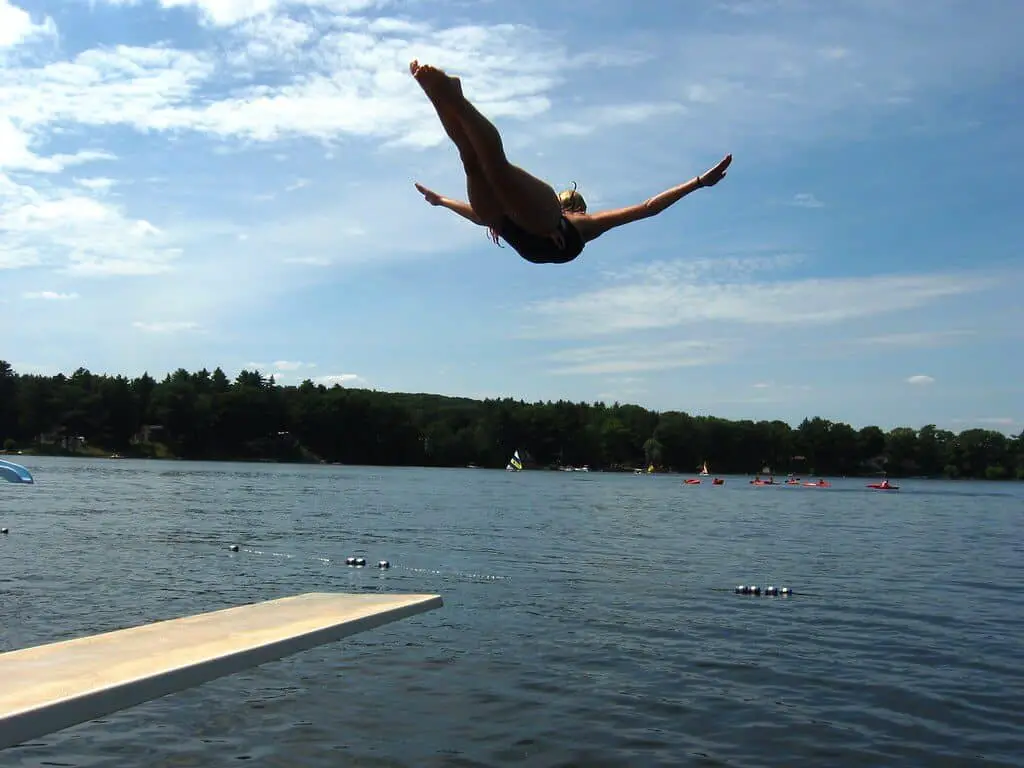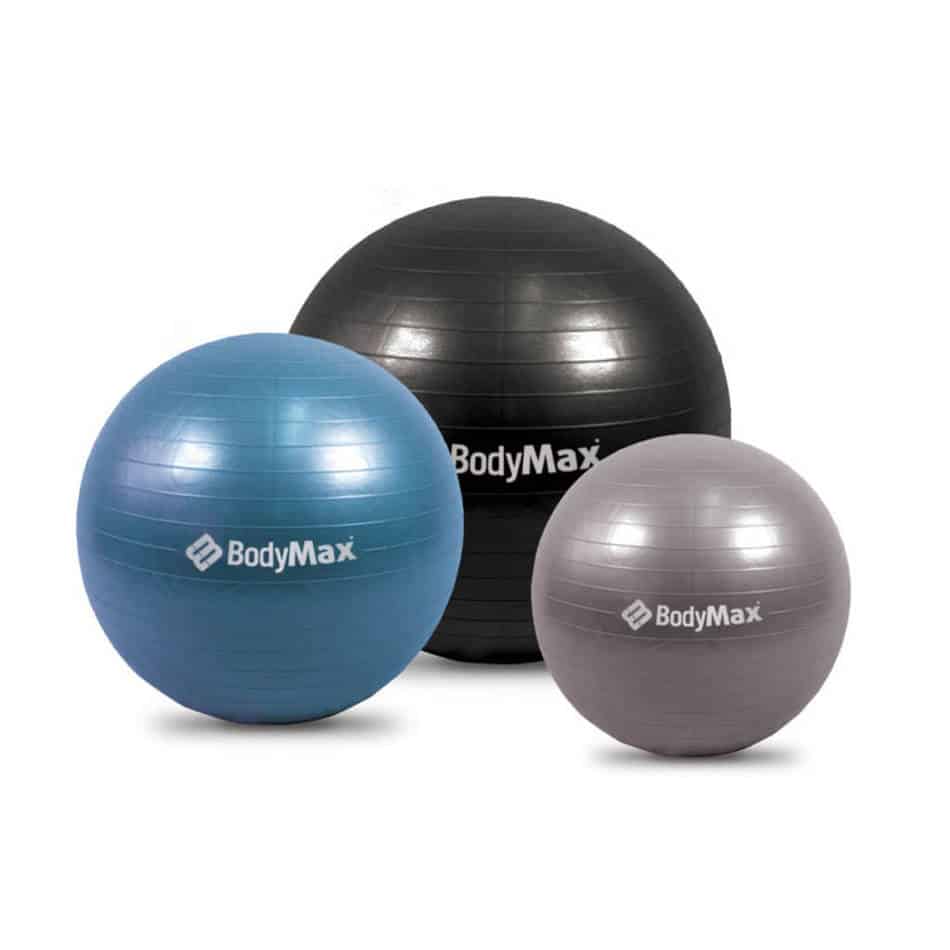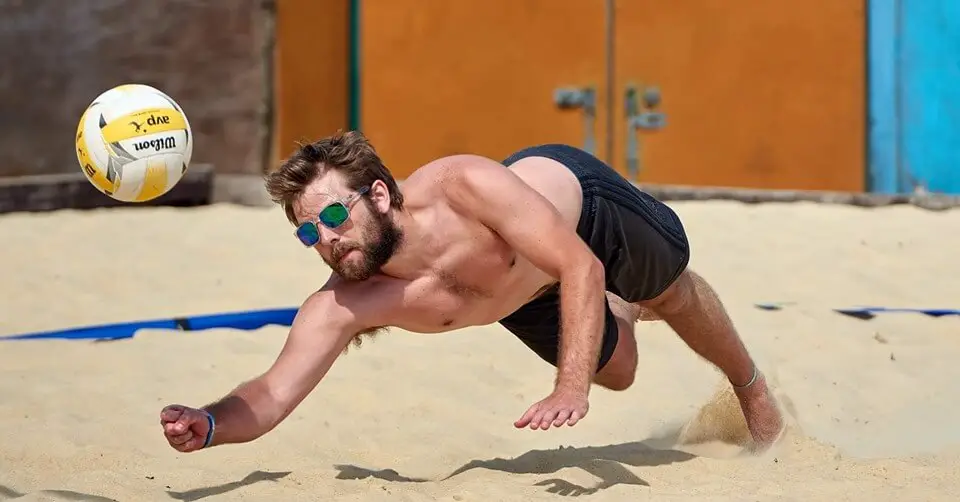When you are playing volleyball there will be many occasions in which you will need to dive for the ball in order to keep it alive.

When you are throwing yourself around on sand you can feel quite safe in the knowledge that you aren’t likely to cause any major injuries or surface burns.
However, Indoor Volleyball is a completely different beast.
The floor is extremely hard and does not sink, spread or compact, on top of this the floor creates a lot of friction so surface burns and grazes are very common.

Due to this fact there is actually a specific way in which you can dive and land to not only give yourself a better chance of getting the ball, but also the best way to avoid injury and surface burns.
Table of Contents
What is a Dive in Volleyball
Sometimes it is simply not possible to get the ball and continue the play using the traditional dig or passing techniques.
With this in mind we may need to get extremely low to the floor in order to play the ball.
The issue with this, is the lower to the ground we are forced to go, the more likely we are to fall over with the ball.
As I said earlier during the intro this isn’t such a problem when we are playing on a nice soft surface such as sand, however indoor volleyball courts are certainly not soft and can lead to lots of different injuries
This is where learning to dive correctly can not only improve our chances to getting to difficult balls but can also help us avoid injuries of all natures.
Just to clarify, you may hear the term swan dive or even dolphin dive being used in volleyball or even mentioned throughout this article.
The swan dive or dolphin dive is the name given to a dive when playing indoor volleyball.

It will become more clear as to why later on in the article.
Volleyball Roll vs Volleyball Dive
The difference between a roll and a dive in volleyball is which part of the body you land on and more specifically what situation you would use both in.
When performing a volleyball roll you will be moving sideways and as such you will most likely land on the outside of your leg and hip.
This is because generally when you are performing a roll you are playing a ball to your side that you otherwise wouldn’t be able to get, also you generally want to be able to get up as quickly as possible so you can be ready to continue to play.
A dive on the other hand is a move you generally use to reach a ball that is in front of you that you need to chase down or stretch for.
Due to this you often land primarily on your chest using your arms to brace your fall and carefully lower you weight down.
How to Perform a Swan Dive
As humans we are naturally top heavy, this means if we are to jump forwards allowing our bodies to go parallel to the floor.
Naturally our shoulders and head will turn towards the ground meaning this would be the first part to hit the ground.
Obviously we do not want to torpedo head first towards the ground so we have to add a few steps between hurling ourselves forward and contacting the floor.
Now we know that we want to stretch out as far forward as we can and maybe even jump to allow us to have maximum reach.
When we carry out this dive it might look somewhat like superman in mid-flight.
Now depending on your timing you may need to contact the ball before you need to touch the floor or maybe you are able to play the ball with one arm while the other hand begins to take the load.
Either way once you have contacted the ball and you are starting to torpedo towards the floor you want to place your hands next to your shoulders and lift your head up. This will ensure when you lower yourself you don’t headbutt the floor or catch your chin on the ground.
Once both of your hands are on the floor and your head is lifted you want to gradually lower your chest to the floor, this will just prevent you landing straight on your ribs or sternum.
Now you have both your hands and your chest on the floor you get into the fun graceful part of the dive.

Have you ever had that one embarrassing relative bust out the worm at a family party or gathering?
If you haven’t you can become that embarrassing relative as the next part of the swan dive is the worm.
Now I don’t mean you are going to dive and then repeatedly do the worm off the court however we do steal some aspects of the worm.

After your chest contacts the floor obviously the rest of your body will eventually be following the chest and touching the floor.
To avoid the rest of our body slamming into the ground and hurting our pelvis, knees and ankles, we want to gradually lower ourselves down until we are completely flat.
To achieve this we want to have a nice bend in our bodies in which our pelvis is higher than our chest, our knees are higher than our hips and ankles/ feet are higher again.
Using this bend and momentum of our fall we want to gradually allow or pelvis to touch the floor, next our knees and lastly our feet and ankles.
Much like someone doing the worm across a dance floor.
If done correctly, not only will this look graceful but also should ensure you leave the dive completely unscathed.
How to overcome fear of Diving
Unfortunately there is no magic method or trade secret to getting over the fear of diving and I completely understand.
However you look at it throwing yourself head first to the ground is no one’s idea of fun.
But touching the ball and keeping the rally alive in moments your team felt were impossible certainly is fun.
The best way to overcome any fear is by facing them.

Now don’t take this as permission to start throwing yourself into the ground head first but instead you want to break down each process much like I have above and practice them in part.
The more your practice, the more comfortable and confident you will become.
Once you have the basics down you will find you can use the swan dive in any circumstance you like, be it diving for a really far ball. Running to chase down a shanked ball or touch of the block or simply a ball you weren’t quite ready for.
How To Practice The Swan Dive With No Equipment
As I said above in order to build up confidence you with the swan dive you want to practice each movement and understand the theory behind each step.
To practice this efficiently I would suggest first, start on both knees and simply allow yourself to fall forward before putting your arms out and lowering your chest to the ground. Even when doing this ensure you lift your head so you don’t catch your chin.
Once you feel confident in lowering yourself you can add a little bit more momentum and difficulty to the movement.
I would suggest starting on one knee and using your standing leg to push yourself forward and upwards slightly.
This will allow you to practice catching your weight and it can also allow you to start practicing your worm routine a little bit whilst not dropping from such a great height.
Once you have got this step down you want to move up to a standing position.
From the standing position you want to step forward and ensure you are very low to the ground before completely jumping. The lower you are to the ground before jumping the less risk you are at from getting injuries.
Simply repeat the above steps until you have the full motion completely nailed.
Now you have all the ingredients of the swan dive, it’s time to really show your stuff and go for gold.
I would suggest taking a few steps into the movement to ensure you have good momentum as well as make the movement more game realistically.
The more you practice the movement the faster I would suggest travelling into the movement.
Once the action feels completely second nature you will know you have mastered the swan dive.
Best Way To Practice The Swan Dive With Equipment
Now there are lots of things you can do with equipment to make mastering the swan dive much easier.
The best ways I have found you can practice the Swan dive is with the use of exercise balls (swiss balls)

If you are still too uncomfortable to perform the swan dive using the above method, I think I could give you a nice little trick using a swiss ball that will have you confidently practicing the move.
Simply get an exercise ball or swiss ball and go on your knees behind the ball, you want to ensure the ball is nice and close to you so much so that it is touching your belly and you can comfortably rest your arms on top of it.
Once the ball is in the right place you want to lean over the top of the ball and using your toes, push yourself off the ground and forward over the top of the ball.
As you do this you will begin to roll directly over the top of the swiss ball.
As your shoulders and head get over the peak of the ball and start heading towards the ground get your arms out in front of you at roughly shoulder width apart, ready to catch yourself.
As your hands contact the floor you want to carefully allow your body to lower to the ground ensuring you lift your head up as you near the floor.
As your hips start to pass over the peak of the ball you will naturally start to form an arch upwards.
Just before your knees begin to pass over the peak, slow the movement right down until you come to a stop.
From this position you can push yourself back over the ball using your arms and keep repeating the process until it feels comfortable or alternatively you can carefully lower yourself to the ground and repeat the movement.
Below is a quick video showing you the action.
As you can see from the video it looks very similar to the example video I showed you earlier.
This allows you to really get a feel for how the movement works and what you should do with your body without the fear of making a mistake and landing flat on your face or in a big heap on the floor.
The Volleyball Swan Dive
In summary The volleyball swan dive although seemingly daunting really isn’t as terrifying as it seems.
I like to compare the situation to when you first ride a bike.
Think back to when you first learnt to ride a bike.
The sheer notion of jumping on that bike without stabilisers or your loved one holding you up seemed terrifying.

Not because the task is particularly difficult, but because we all know if we start hurling towards the hard ground it is likely to hurt.
Similarly to riding a bike the task is much easier when moving.
When we put aside the fact that we may get injured and focus primarily on the task you will see the art of swan diving really is quite easy to perform and even easier to master.
It is often thought of as an advanced move but it is highly likely that at some point even in your early days of volleyball you will need to stretch or dive for a volleyball.
In these situations you have two options. React to the ball and risk hurting yourself.
Or.
Learn how to dive correctly and start keeping balls alive that you never even thought was possible.
Not only will start picking up more balls but you will look damn good whilst doing it and walk away feeling great with no injuries.

